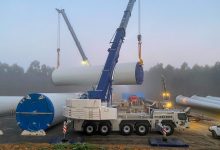Australia achieved record levels of carbon abatement and renewable energy generation over the 2019-2020 financial year, bolstered by increased of levels of “voluntary ambition” in the private sector and the emergence of “vibrant carbon markets.”
New data taken from the Clean Energy Regulator’s annual report for the 12 months to June 30 reveals a record total of 4349 megawatts of large-scale renewable capacity – or 374 new renewable energy power stations – was added, enough to meet the 2020 Large-scale Renewable Energy Target.
 This record addition of new large-scale solar and wind power contributed to a total of 13.4 million tonnes of carbon abatement delivered under contract for the year, to the value of $165 million.
This record addition of new large-scale solar and wind power contributed to a total of 13.4 million tonnes of carbon abatement delivered under contract for the year, to the value of $165 million.
“We continued to see strong investment in renewables, with more than 4300 megawatts of large-scale renewable capacity accredited during the year,” said CER chair David Parker in his annual review.
“In September 2019, we announced we had accredited enough capacity to achieve the 2020 Large-scale Renewable Energy Target of 33,000 gigawatt hours. This milestone represents the hard work of a growing and dynamic renewables industry.”
Among the stars of the financial year included the 532MW for Stockyard Hill wind farm in Victoria, which distinguished itself as the largest accredited wind farm in Australia, yet.
All told, this brings the total number of accredited renewable power stations in Australia to 1610, with a total capacity of 24,908MW, the report said.
 “As at 30 June 2020, Australia had 24.9 gigawatts of accredited large-scale capacity under the Large-scale Renewable Energy Target, with another 5.2 gigawatts in our pipeline. This included 2.9 gigawatts that had reached financial close, and 2.3 gigawatts with power purchase agreements.”
“As at 30 June 2020, Australia had 24.9 gigawatts of accredited large-scale capacity under the Large-scale Renewable Energy Target, with another 5.2 gigawatts in our pipeline. This included 2.9 gigawatts that had reached financial close, and 2.3 gigawatts with power purchase agreements.”
Investment in small-scale renewables, namely rooftop solar, also continued to boom, with an additional 2294 megawatts of small-scale capacity validated, bringing total capacity installed under the Small-scale Renewable Energy Scheme (SRES) to 11,427 megawatts – enough to displace 17.8 million megawatt-hours of electricity.
 In terms of certificates generated through the federal government renewable energy schemes, the CER says it validated a total of 30,496,990 large-scale generation certificates (LGCs) compared with 26,250,722 validated in 2018–19, as a result of an increase in electricity from renewable sources. Each certificate represents one megawatt hour of renewable energy generation.
In terms of certificates generated through the federal government renewable energy schemes, the CER says it validated a total of 30,496,990 large-scale generation certificates (LGCs) compared with 26,250,722 validated in 2018–19, as a result of an increase in electricity from renewable sources. Each certificate represents one megawatt hour of renewable energy generation.
The year also saw a 70% increase in voluntary surrender of Australian carbon credit units and large-scale generation certificates – a trend the CER said was driven by increased corporate ambition underpinned by green goals.
“Vibrant carbon markets are emerging, as markets diversify into new sources of demand,” said Parker in his review.
“We’ve seen growth in the voluntary surrender by companies and governments of Australian carbon credit units and large-scale generation certificates, which together have increased approximately 70 per cent on 2018–19.
“This is largely due to corporate ambition to use more renewable energy or to become carbon neutral and we expect more growth in voluntary surrender as more corporations commit to their own net-zero emissions targets.”
Parker also noted the success of the CER’s crackdown on compliance with the government schemes, with a particular focus on the rooftop solar sector.
“In 2019–20, a significant focus for us was targeting non-compliance and fraud associated with the misuse of Clean Energy Council accredited installer details in the Small-scale Renewable Energy Scheme,” the report said.
“The misuse of installer details poses a significant risk to the safety of the community and integrity of the scheme, with broad implications for government and industry stakeholders.”
Over the course of the year, the CER said the compliance initiative had resulted a total of 51 rooftop solar installers being referred to the Clean Energy Council for an accreditation review and 51 installers being referred to relevant state or territory electrical safety and/or consumer protection regulators.
Elsewhere, one Clean Energy Regulator Inspector had their appointment revoked, two installers entered into enforceable undertakings, and two agents had their registration permanently suspended.
During the same period, the CER closed 24 investigations, including finalised court matters and matters resolved by non-court action, including accepting enforceable undertakings or suspending the registration of non-compliant participants and removing them from the schemes.
“Our compliance approach continues to mature to ensure scheme participants remain engaged, active and compliant, to protect the integrity of the schemes we administer,” said Parker in his review.
“I am proud of the work of our agency this year and these achievements provide us with a good footing to implement relevant parts of the government’s response to the recommendations of the Examining additional sources of low-cost abatement: expert panel report, referred to as the King Review. This will be an area of focus for us over the coming year,” he said.







